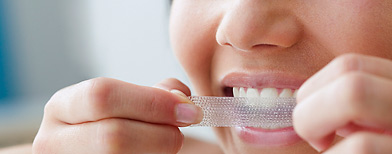Up to 65% of people who bleach their teeth experience some pain.
About to Whiten Your Teeth? Read This First!

Before you run out for a lunchtime tooth-lightening session or apply your umpteenth -- or your first -- set of whitening strips to your bicuspids at home, here are four things you should know about chemical spiff-ups for your smile:
1. Give it a rest. There's a reason some products should be used only four times a year: worries about overuse. If lightening becomes as regular as a monthly haircut in your grooming routine, you may damage tooth enamel and take your teeth to the point of ghostly translucence. That's not pretty.
2. It's not always ouchless. The most common side effects of tooth-whitening, whether it's DIY in your bathroom or a professional job, are sensitive teeth and irritated gums. From 10% to 65% of people who give tooth bleaching a try have some pain, experts say. Usually, it's short lived, but to avoid it in the first place, try using a toothpaste that reduces sensitivity for several days before your procedure (and for a few days or weeks afterward). Taking an ordinary painkiller (like ibuprofen) before a bleaching session helps, too.
3. Think twice about bleaching at the mall. One recent CBS-TV investigation of "whiten while you shop" kiosks and storefronts in malls found that while employees may wear lab coats, they usually aren't dental-care professionals. And they aren't equipped to evaluate dental problems -- so underlying dental issues, like cavities, could be made worse by bleaching. One place used bleaching agents that were dentist-office strength, which can be two to three times stronger than the carbamide peroxide gel found in some home whitening kits approved by the American Dental Association.
Check out these dental tools you'll want to use to keep teeth and gums healthy.
4. Ask your dentist what's possible. Bleaching can make your pearly whites several shades whiter -- especially if coffee, tea, tobacco, or plain old aging are to blame for that gray-yellow grin. But the results are less reliable if your teeth were stained by the use of the antibiotic tetracycline or by too much fluoride in childhood. Also, if you have tooth-colored fillings or crowns, bleaching can cause a color mismatch. Talk to your dentist about whether a possible variation in "whites" in your mouth will be noticeable.

No comments:
Post a Comment